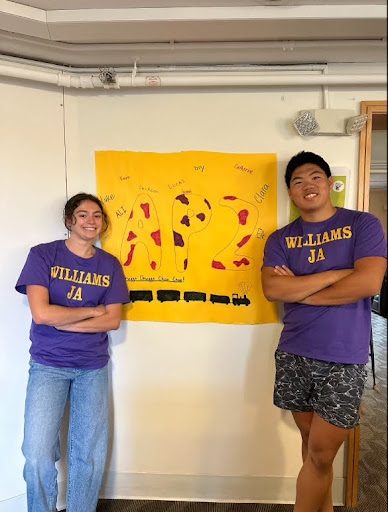
Junior Advisors (JAs) know it well. The JA shirt is a classic purple and yellow garment that, during the tumult of First Days, distinguishes the seasoned JAs from the sea of newly minted first-years. While most students at the College recognize the iconic shirt, many may not realize that it is, in fact, a singular piece of clothing reworn each day. The College provides each JA with only one shirt, a practice that began with the JAs to the Class of 2026. In prior years, the College had generously issued two shirts.
At the end of JA training, Dean of First-Year Students Christina Walsh officially presented each JA with their shirt: Walsh read out each JA’s nickname, the one emblazoned on the back of their shirts, and then threw them their lone tee. “It was a good time,” said Jamie Woods ’26, JA to the Willy 2 entry. “It was fun.”
The College requires that the JAs — who are responsible for guiding the incoming class through their first year at the College — wear these shirts during the start of the year to identify themselves.
The glory of this visibility, though, has some costs. “It kind of made me feel powerless,” Woods said of the requirement to wear the shirt throughout First Days. “But it honestly took some stress off. Because, you know, for the first day of school, it’s like, ‘I gotta look good, what am I gonna wear?’ The fact that I didn’t have any choices to make made it easier to dress up.”
“My frosh were making fun of me over it,” said Josh Rubel ’26, a JA for MD 3. “They were like, ‘Do you have any other clothes?’”
Lucy Kossuth ’28, who lives in Sage 3, said she noticed almost immediately that her JAs were wearing the same shirt every day. “At the end of First Days, I said to my JAs, ‘Every day, you guys? This is, like, commitment,’” Kossuth said. “I asked them, ‘Are you going to get tortured by [President] Maud [S. Mandel] if you don’t wear your shirt?’ And my JA was like, ‘Yeah,’ and I was like, ‘Okay, cool.’”
“I didn’t feel swaggy,” said Mariel Baez ’26, Kossuth’s JA. “It’s a T-shirt, so it gets dirty and smelly really fast.”
Baez was not the only JA who contended with an unclean T-shirt. But this year’s class of JAs took the challenge in stride, developing innovative laundry strategies to combat the dirt and smell. JAs even established collective T-shirt washing routines.
“We did, for a second, think about making our frosh do our laundry,” Willy 2 JA Daria Lukinova ’26 joked. “But we didn’t.”
Instead, the Willy JAs took turns washing the T-shirts every day. “One person would do everyone’s laundry, and then they’d deliver it,” Woods said. “It was a beautiful bonding moment.”
“Some JAs would even come in the morning and fold the shirts neatly and leave them in their common room,” Lukinova said. “It was a full-service type of deal.”
The Mission JAs employed a similar communal laundry strategy, but struggles persisted. “It was really hard to find time to do laundry,” Rubel said. “It really just would have been a lot easier if we were able to maybe do it once every couple days — just like, even with a second shirt, you know? Just the second shirt would have been great.”

Not everyone managed to achieve success, though. “You didn’t hear this from me, but some of the JAs did not wash their shirts,” Lukinova said.
Despite the struggles of their involuntarily minimalist lifestyle, many JAs expressed love and pride toward the garment. “[Being a JA] didn’t really feel real until I was wearing that shirt, and people were coming [to campus], and I was like, ‘Wow, it’s happening,’” Woods said.
“I really enjoyed wearing it,” Baez said. “It elevated my perception of myself as a JA. It was really nice because frosh would come up to me with questions that frosh would only ask a JA. It helped point frosh toward me for guidance.”
Along with identifying the JAs as a unified group, the shirts also offer some insight into each JA’s personality through the nicknames on the back. Written across the back of Baez’s shirt, for example, is the phrase “Mama Mariel.”
“In high school I used to be called Mama Mariel, because I would say I’m, you know, pretty maternal,” Baez said. “And I just wanted to keep the tradition of maternity alive.”
As dirty and smelly they may be, keeping the tradition of being a JA alive is, one might argue, precisely what the JA shirts accomplish.
[Editor’s note: Shane Stackpole, who is an executive editor for the Record, is a JA and was not involved in the writing or editing of this article.]








